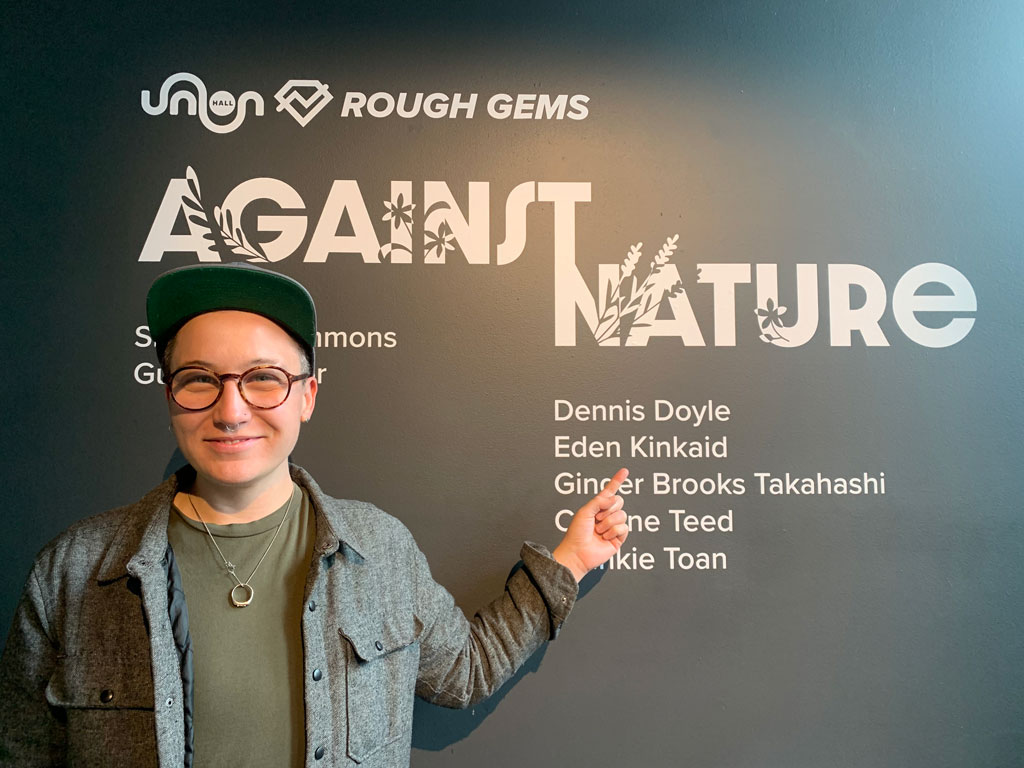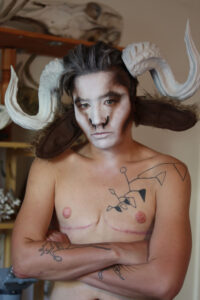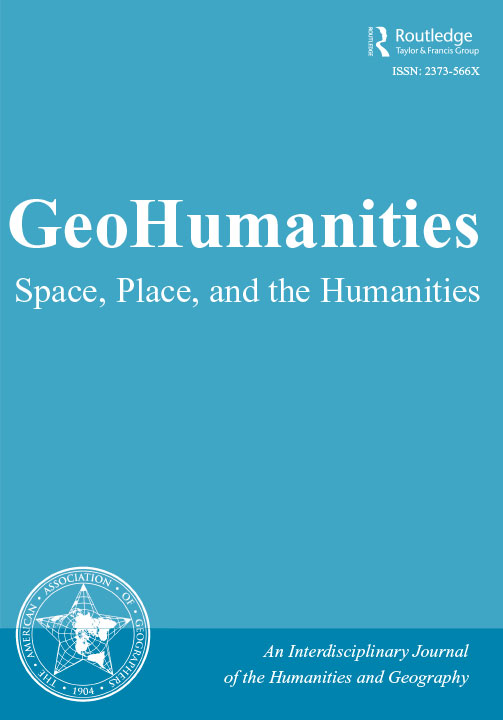Member Profile: Eden Kinkaid

It seems like everything is possible in geography
“It was one of those cosmic coincidences that I ended up in geography,” says Eden Kinkaid, who recently earned their doctorate in the field from the University of Arizona. “It is really a great intellectual home for me. I can’t imagine being anywhere else. l have all kinds of critical concerns about geography as a discipline, but as an intellectual space, the geographic imagination totally suits me. I love how interdisciplinary and sort of anti-disciplinary it is — when folks ask me what a human geographer is, I tell them that I am one-third social scientist, one-third philosopher, and one-third artist. In a certain sense, intellectually at least, it seems like everything is possible in geography.”
Kinkaid has invested deeply in exploring just how far the possibilities of geography go: as a creative geographer; co-editor of the journal You Are Here; creator of installations and sculptural inquiries; editor of @wtfisgeography, a playful, wide-ranging Twitter account “offering brief definitions of big words in geographic theory;” and as an investigator of the exclusions of the discipline and limitations of geography curriculum.” Kinkaid is also devoted to creating dialogues about the nature of geography and about how feminism and queer/trans thought can interact and strengthen one another.
“…as an intellectual space, the geographic imagination totally suits me.”
Kinkaid’s curiosity and generosity of vision came in handy during the COVID-19 pandemic, when they were one of the many graduate researchers who had to pivot their work in light of travel restrictions. “I was six years into graduate school and just about to leave for my final stint of fieldwork in north India on a Fulbright fellowship when the pandemic began. I had to literally change my project overnight.” The change led Kinkaid to study food systems, food culture and development in Tucson, where they were in school.
“Working in my own country of origin and in my first language made research much more simple,” says Kinkaid. “I had never done collaborative research, so I learned a lot. Whereas before I would never think to do qualitative research collaboratively, now collaboration is my first impulse. Doing research in my own community enabled me to use my research to actually influence some kind of change in that community. For example, our research on the pandemic’s impact on local food systems was turned into a public research report that folks working in the local food system used to advocate to the legislature for support for food assistance that would also help local farmers. They also used it for a local food system strategic planning process. So that was cool to see.”
Kinkaid’s dissertation research on the cultural politics and political economy of food-based development in Tucson has also prompted local dialogues about whiteness, social justice, and equity within Tucson’s gastrodevelopment project.
Probing the Discipline’s Boundaries and Absences
Kinkaid’s incursions into the narratives, inclusions and exclusions of geography developed concurrently with their interest in feminist and queer thought. “I never set out to study feminist theory or queer theory — it was not really on my radar. I was introduced to feminist theory by my mentors and later encountered queer theory. When I entered graduate school, I didn’t call myself queer. This identification actually emerged at the same moment I started studying geography, when I moved to central Pennsylvania and started in a program there. And the funny thing is that my identification as genderqueer emerged because of a kind of misfit within the culture of both geography and the town I was living in. The way I thought, the way I moved, the way I presented myself seemed at odds with the spaces I was in, intellectually and institutionally. Then I happened into queer theory and found a language for everything I was feeling — the way that I experienced space and my body — and a name for this growing awareness of my body as a source of dissonance in these very cisheteronormative surroundings. I became a queer geographer because I had to — I needed this kind of self-knowledge, epistemology, and theory to navigate what have often been stuffy if not toxic intellectual and institutional spaces. Along the way, I found that being queer and trans is a powerful vantage point for thinking about a lot of geographic questions.”
Kinkaid says that it is hard to draw a common thread across all of their work, “But in this moment, I am reflecting on how my intellectual and institutional work I do in geography are inseparable from the fact I am queer and trans. In a certain way, that is the common thread across lots of work that, on the surface, is not necessarily about that. For example, the way I encounter various philosophical traditions and my critiques of those traditions emerge from the fact that I don’t have the same body as many of my colleagues, that my experience of space and subjectivity is radically different than theirs, and that my experience of my body and self seems to be at odds with the world and its ‘common sense.’ I am challenging my colleagues to rethink their intellectual investments because, a lot of the time, those intellectual stances encode forms of erasure, exclusion, and domination that I experience as constraints on my body, on my world, on my life. My work on queer and trans life obviously emerges directly from the same place — from the unique vantage point afforded by being trans in spaces that are oblivious to trans existence, if not actively hostile to trans life.”
Kinkaid’s intellectual and institutional work around diversity, equity, and inclusion, comes from the same place. “The work finds me,” they say. “It is the work I have to do to render myself and the harm I and others encounter here legible.” My experience of being queer and trans in geography has opened up what feels like a kind of institutional shadow world that I have to navigate — the kinds of professional problems that confront me here (many of which I have written about) are completely bizarre and unrelatable for my peers and mentors. I have encountered a lot of cultural and institutional problems in geography that many don’t see, or refuse to see, which has raised my awareness of the kinds of so-called invisible barriers — cisheteronormativity, cultures of whiteness, ableism, class culture, etc. — that prevent minoritized people from thriving in these settings. So I have become an ethnographer of that shadow world and tried to render it legible to my colleagues — and to call out the logics that produce such inhospitable spaces, not only for queer and trans people, but also for people of color of all genders and sexualities in the discipline and other minoritized people.”
 Kinkaid’s artistic work — including their recent natural history, with its nod to Enlightenment-era specimen collection and featuring Kinkaid’s months-long transformation into a satyr — comes from a rejection of the world as it is currently presented and mediated through cisheteronormative terms, and “a yearning for another space, one in which queerness and transness are not so circumscribed and subject to misrecognition and violence.” Kinkaid brings together their spatial understanding with artistic practice to quite literally create space, a space to “challenge and scramble the logics that frustrate my existence, to experiment with a new kind of grammar of existence and build a world that feels more like a home.”
Kinkaid’s artistic work — including their recent natural history, with its nod to Enlightenment-era specimen collection and featuring Kinkaid’s months-long transformation into a satyr — comes from a rejection of the world as it is currently presented and mediated through cisheteronormative terms, and “a yearning for another space, one in which queerness and transness are not so circumscribed and subject to misrecognition and violence.” Kinkaid brings together their spatial understanding with artistic practice to quite literally create space, a space to “challenge and scramble the logics that frustrate my existence, to experiment with a new kind of grammar of existence and build a world that feels more like a home.”
Asked if they have advice for graduate students, Kinkaid counters with advice for faculty: “Learn from your students and junior colleagues. The climate of higher education has drastically changed over the last couple decades, and it is currently in freefall. We’re also in a moment of generational change, where a much more diverse group of people is moving into the discipline and struggling to find space here. So it is necessarily a moment of upheaval and change: the status quo of geography — which, to be clear, is racist, colonialist, sexist, and queerphobic — is getting unsettled. So it is crucial that the people with institutional power and various forms of privilege — senior professors, particularly the cis-het white ones — keep learning, embrace discomfort, and enter into real solidarities with graduate students and junior faculty so we can make space for minoritized people here and create more just futures for geography.”

